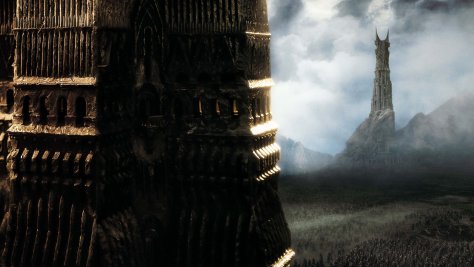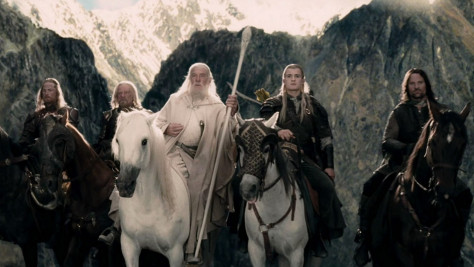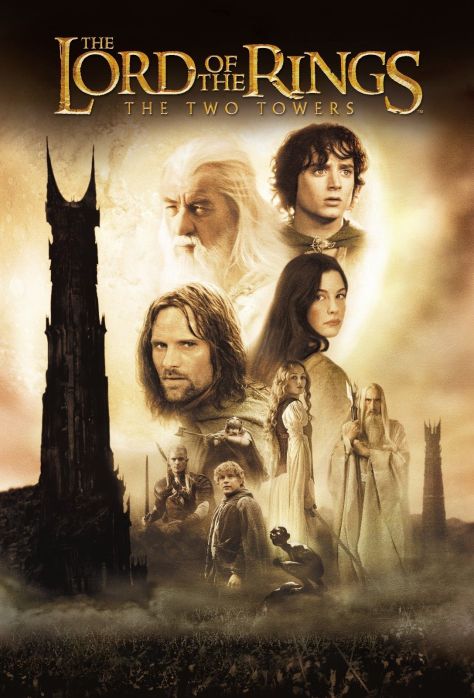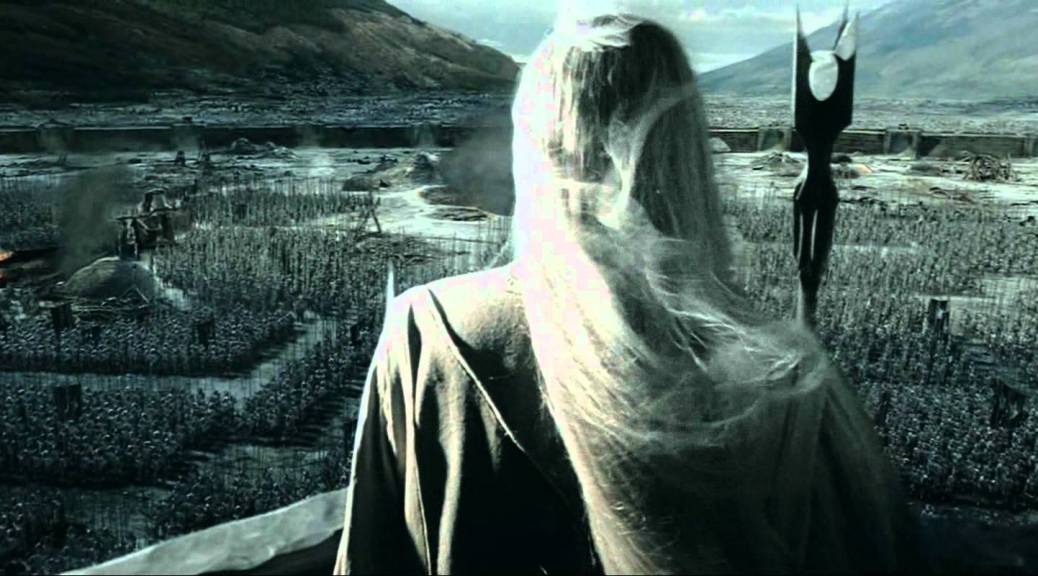
Every other month, we take a look at a movie from the Internet Movie Database’s List of the TOP 250 FILMS OF ALL-TIME. These are movies that transcend a simple “My Favorite Scene” column. These are movies that are hard to just pry five gems from, but we do and examine the film overall. We’re on our fifteenth installment in this series. Click on the link here to check out previous installments from #1 The Shawshank Redemption to #14 Inception.
In planned trilogies, middle chapters are the trickiest. They don’t have a beginning or an end. They tend to be the darkest night before the dawn of the finale, but it’s possible to go too dark. You can lose the momentum of your opening and set up narrative hurdles for the finale that are impossible to overcome. A perfect bridge movie is rare, and with the possible exception of The Empire Strikes Back, the best one ever made is The Lord of the Rings: The Two Towers.

Narratively much more complex than the linear Fellowship of the Ring, The Two Towers follows the splintered fellowship on their various journeys while introducing a host of new characters. Peter Jackson, Fran Walsh, and Philippa Boyens structured the film version of The Two Towers much differently than the book, pushing much more of the finale into The Return of the King while using The Two Towers as the crux of character development in the trilogy.

The Fellowship of the Ring ended on such a high-note and cliffhanger that The Two Towers could have easily dropped the ball on all of the pitfalls of a middle chapter, or shortchanged all of the characters that aren’t even introduced until the second film. Gollum, Treebeard, Theoden, Eowyn, Eomer, Faramir, Wormtongue, and others all have to be introduced, Gandalf re-introduced, and all are done so without short-changing any. The film also introduced a completely new type of acting to bring Gollum to life, and features a finale with two epic battle sequences. All serve to perfectly set up The Return of the King to finish Tolkien’s epic. Middles aren’t glamorous, but they don’t come any better than The Two Towers.
1. “Gollum and Smeagol”
Gollum barely makes an appearance in the first film, and to bring him to life as the first really convincing CGI character in cinema history, WETA Workshop and actor Andy Serkis used motion capture technology. Serkis acted all of Gollum’s scenes wearing an absurd suit with markers that were later used to digitally paint Gollum’s form over Serkis.
Gollum is such a key character in LOTR that he had to be so convincing that you never thought of him as a special effect, and the technology can be credited for a lot of the success, but the lion’s share comes from Andy Serkis. The man invented a completely new way to act in this film, and created a character so morally complex, funny, evil, pathetic, and endearing that he stole the film. The most impressive sequence is the self-argument between Gollum and Smeagol: a masterpiece of both acting and editing to create an unforgettable scene both hilarious and frightening.
2. “Foundations of Stone”
How to begin The Two Towers was a tough decision for Jackson. Do you give a recap? Do you just jump right in? How best to start? He settled on returning to perhaps Fellowship’s most iconic moment: the fight between Gandalf and my favorite movie monster of all-time – the Balrog. This is a perfect example of a way the movies can do something the books didn’t. We get to see the entirety of the battle between the Grey Pilgrim and Balrog. The connection between Gandalf’s fall and his return is much clearer in the films than in the book, in part because we see the whole journey. It’s a brilliant way to immediately immerse the audience back into Middle-Earth and solve a tricky narrative hurdle: that of the transformation of Gandalf from the Grey to the White.
3. “Helm’s Deep”
Peter Jackson loves battle scenes, and he always looked at Helm’s Deep as perhaps the most important sequence in The Two Towers. The battle, which took a month of day shoots, and three months of miserable night shoots (mostly wet night shoots as the battle happens in the rain) to create, stands as arguably one of the best battles ever created. It’s not so much a battle as an Alamo scenario. Our heroes are hopelessly outnumbered, and once the “impenetrable” fortress is breached, the fight becomes not about winning, but surviving long enough to allow hope a chance to win the day.
4. “Forth Eorlingas!”
The hope of Helm’s Deep is that they can hold out long enough for Gandalf to return with reinforcements. Rescues do not come any more epic than the White Wizard’s return with Eomer and his forces. A stunning, near-vertical cavalry charge at the invaders, timed perfectly with the rising of the sun wins the battle and the day.
5. “Theoden’s Exorcism”
Once Gandalf returns, his first order of business is to oust Saruman’s control over the kingdom of Rohan, where the turncoat leader of the White Council has possessed Rohan’s king: Theoden. In a wonderful sequence that introduces us to the players in Rohan, Gandalf battles Saruman through his possessed vessel. Gandalf makes good on his promise to draw out Saruman’s influence like poison from a wound, and Theoden is transformed before our eyes from a wizened husk to a ruler once more. Credit again has to be given to the film’s editor, Michael Horton, for skillfully flashing between Gandalf, Theoden, and Saruman in such a way to create a kinetic battle for the soul of a king.


The Battle of Helm’s Deep is one of my favorite movie sequences ever. Great artistry throughout and arguably the best sequence in the entire trilogy.
LikeLiked by 1 person
It’s tough to pick a best scene from that trilogy but in terms of what it took to put together and final result; Helm’s Deep certainly deserves consideration. After they finished filming, cast and crew spent the rest of the shoot wearing “I Survived Filming Helm’s Deep” shirts.
LikeLiked by 1 person
Two Towers is magnificent, and the scenes you chose probably are the standouts.
Three things do kind of bug me about the film. The Aragorn fake-out, for one. I’m sure there was a reason for it. Maybe structurally the script needed something at that point, and there was nothing convenient in the book, so they thought their own thing up. It was the wrong thing to think up. Also, the montage sequence with the narration by Galadriel brings the film to a halt. Up until that point I was getting carried along by the story, as if on a river, and the narration sequence took me out of it and totally ruined the pacing, and I never fully got back into step. Also, the film really, really did need Shelob. I think I can see why they moved her to ROTK, but without her, TT feels too amorphous. Yes, it’s the middle part, but the chapters ought to stand as their own movies too, and the lack of the book’s big climactic scene involving Frodo made the movie feel too much like connective tissue.
LikeLiked by 1 person
The Aragorn fakeout doesn’t bother me because it was the only way to keep Arwen in the film series without there being the gap in her character that is in the book, where she just disappears for 800 pages. I think the creative license was justified and it gave Helm’s Deep an idea of the size of the force coming. The Galadriel recap, is at the midpoint of the trilogy; it’s not my favorite decision, but again, it keeps her in the mix and there are so many moving parts that a pause to reflect doesn’t hurt the film. It did not need Shelob. Helm’s Deep and Osgiliath were such huge final set pieces that tacking on another 30-40 minutes to get to Shelob would have ruined the movie’s pacing and bloated it beyond practical releasing. It’s the book’s break point; not the film’s. Giving Frodo a showdown with the Nazgul in Osgiliath was fine and Gollum was more than villain enough. In the end though, these are ONE film. They do not stand on their own, nor were they ever intended to do so. It’s an 12 hour 6 minute movie.
LikeLiked by 1 person
If they wanted Arwen in the air, that is understandable, I just wish they had stretched thier imaginations more because the fake-out does not work. And yes, it is one movie, just like it’s really one long book. Yet each installment has its own identity. People will always watch it as three separate installments. The Frodo part of the story needed more to it. It feels like a subplot. There were things that could have been trimmed, starting with, perhaps, the fake-out and the narration sequence, to make room for Shelob. It would have been well worth it. But Jackson delivered a masterpiece, and it’s not like the BO was remotely hurt by any of these things, and I sure wasn’t put off. All films could be better. Except The Godfather, that one attained perfection.
LikeLike